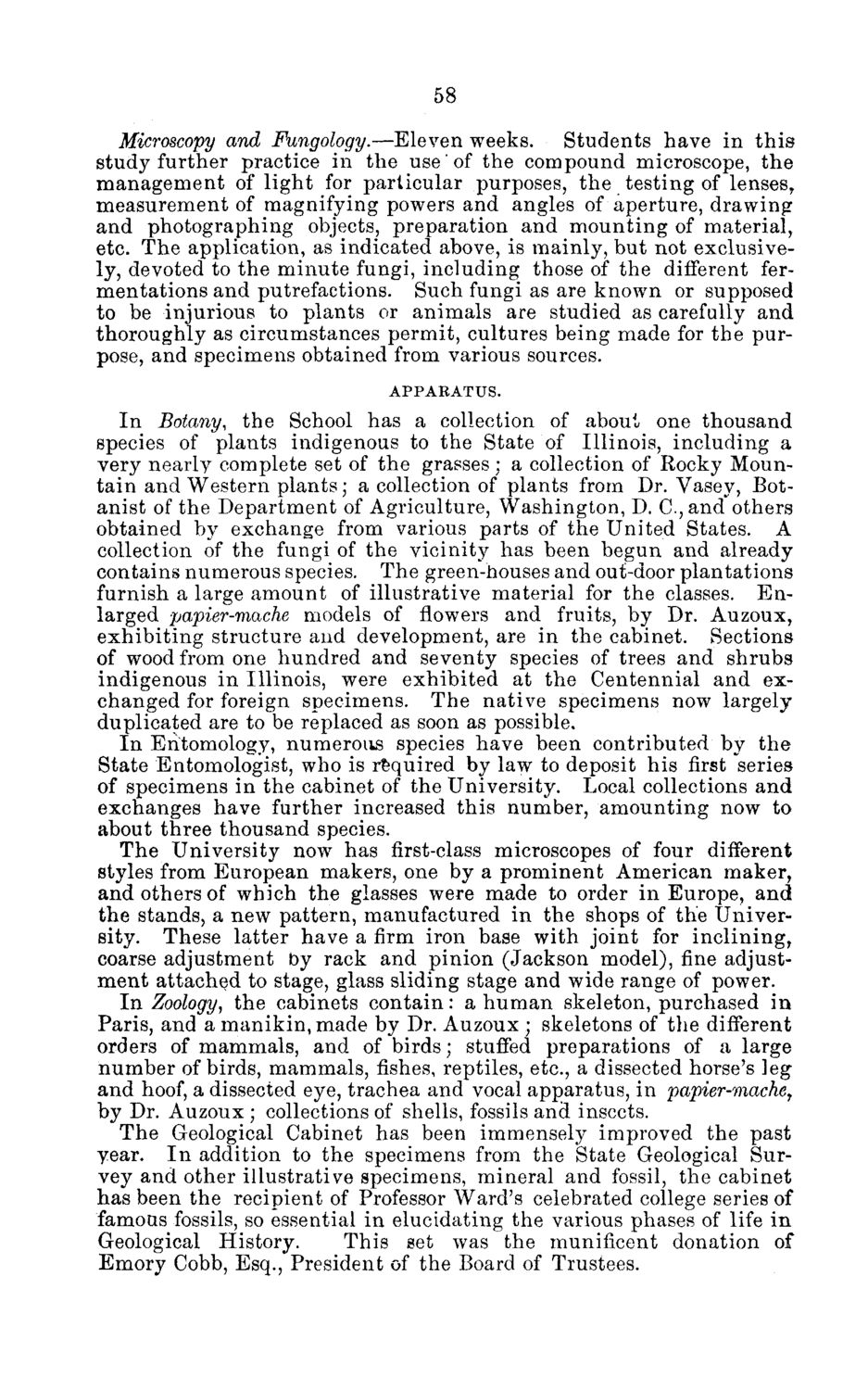| |
| |
Caption: Board of Trustees Minutes - 1876
This is a reduced-resolution page image for fast online browsing.

EXTRACTED TEXT FROM PAGE:
58 Microscopy and Fungology.—Eleven weeks. Students have in this study further practice in the use of the compound microscope, the management of light for particular purposes, the testing of lenses, measurement of magnifying powers and angles of aperture, drawing and photographing objects, preparation and mounting of material, etc. The application, as indicated above, is mainly, but not exclusively, devoted to the minute fungi, including those of the different fermentations and putrefactions. Such fungi as are known or supposed to be injurious to plants or animals are studied as carefully and thoroughly as circumstances permit, cultures being made for the purpose, and specimens obtained from various sources. APPAKATUS. In Botany, the School has a collection of about one thousand species of plants indigenous to the State of Illinois, including a very nearly complete set of the grasses; a collection of Rocky Mountain and Western plants; a collection of plants from Dr. Vasey, Botanist of the Department of Agriculture, Washington, D. C.,and others obtained by exchange from various parts of the United States. A collection of the fungi of the vicinity has been begun and already contains numerous species. The green-houses and out-door plantations furnish a large amount of illustrative material for the classes. Enlarged papier-mache models of flowers and fruits, by Dr. Auzoux, exhibiting structure and development, are in the cabinet. Sections of wood from one hundred and seventy species of trees and shrubs indigenous in Illinois, were exhibited at the Centennial and exchanged for foreign specimens. The native specimens now largely duplicated are to be replaced as soon as possible. In Entomology, numerous species have been contributed by the State Entomologist, who is required by law to deposit his first series of specimens in the cabinet of the University. Local collections and exchanges have further increased this number, amounting now to about three thousand species. The University now has first-class microscopes of four different styles from European makers, one by a prominent American maker, and others of which the glasses were made to order in Europe, and the stands, a new pattern, manufactured in the shops of the University. These latter have a firm iron base with joint for inclining, coarse adjustment by rack and pinion (Jackson model), fine adjustment attached to stage, glass sliding stage and wide range of power. In Zoology, the cabinets contain: a human skeleton, purchased in Paris, and a manikin, made by Dr. Auzoux ; skeletons of the different orders of mammals, and of birds; stuffed preparations of a large number of birds, mammals, fishes, reptiles, etc., a dissected horse's leg and hoof, a dissected eye, trachea and vocal apparatus, in papier-mache, by Dr. Auzoux ; collections of shells, fossils and insects. The Geological Cabinet has been immensely improved the past year. I n addition to the specimens from the State Geological Survey and other illustrative specimens, mineral and fossil, the cabinet has been the recipient of Professor Ward's celebrated college series of famous fossils, so essential in elucidating the various phases of life in Geological History. This set was the munificent donation of Emory Cobb, Esq., President of the Board of Trustees.
| |